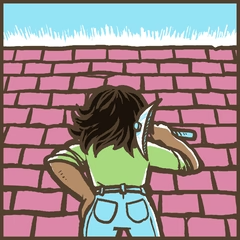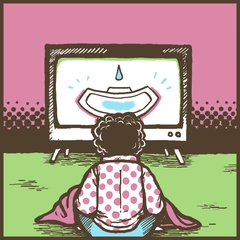
The Brick Wall.
The Brick Wall.

By Índio AB.
The wall wasn’t always there.
It was built, gradually, over hundreds of years.
Built by men who had plans, and strengthened by those who were just going with the societal grain.
It blocked out the sun and cast a nasty shadow over those that looked towards it.
As it sat there, many began to see it as a normal part of their lives. They would joke about it, only to see the wall grow in size.
But if this wall was man-made after all, then it could be toppled just as it once had been raised.
Nobody could do such a thing alone. It would have to be a joint effort, by people from all walks of life to tear that wall down piece by piece.
Few aspects of a woman’s life are as heavily stigmatized as the period.
In countries with poor gender equality, the period can often serve as the catalyst for oppression. A shameful act that betrays the image that women are supposed to upkeep.
It is no surprise that the reason the wall - period stigma- was built, was through sexism. In almost every world culture, there are societal norms that perceive women within a ‘fragile’ and ‘soft’ lens - most prominently seen throughout the people groups of Eurasia and Northern Africa.
If women are supposed to be “sugar, spice and everything nice”, a societal norm is created that leaves little room for personal freedom, career opportunities, and - you guessed it - bleeding.
In all Western and Eastern cultures, the period has been seen as a shameful contradiction to the clean, flawless image that women are supposed to keep with. Quite frankly, people are squeamish to talk about it.
I still remember taking sex ed as a young boy. Our class would be split up into boys and girls, and the girls would go off into a different class to learn about the menstrual cycle. Meanwhile, we boys would learn about only the stuff that we needed to know, like wet dreams and growth spurts. Because of this, the elusive ‘period’ became something only rumoured about in playground talk.
I’m 18, went to a progressive high school in a progressive country, and only learned how a tampon worked when I was 15, after watching a YouTube video. I think we can see the problem here.
A patriarchal society mixed with a total lack of menstrual education for boys throughout most of the world is a recipe for disaster. This is how the wall was built.
Many people receive their informal education through the media.
Period related jokes still turn up in the odd comedy act, and usually not under a flattering light. In advertisements for period products, blood is commonly depicted as a blue liquid, as not to ‘gross out’ the audience.

Pad advertisements on television, featuring the quintessential ‘blue liquid’.
Calling someone “hormonal” and “hysteric” is still a widely-used insult. In rural Nepal, the tradition of ostracising menstruating women and girls into squalid huts still continues. Even in the likes of England and New Zealand, a lack of funding towards menstrual products leads many girls to miss out on school due to “period poverty”. The question today burns more than ever: How will we tear down this wall? Well, the cracks are already there.
Progress is being made, and everyone can help.
Removing the stigma around menstruation comes through discussion. To be able to talk about periods in casual conversation with friends, colleagues and family can help bring it into the public vernacular.
This goes hand in hand with education. When it comes to discussing puberty in schools, there should be no segregation by gender: Even if it doesn’t apply to you, it applies to half of everyone else. Nothing is not worth teaching.
Risks are also worth taking. In 2015, Kiran Gandhi famously ran the London Marathon while free bleeding, raising money for charity in the process. In 2017, the first-ever Period Con was held. The more discourse on the subject of menstruation, the better.
Once public discussion of periods opens up for good, it will be remarkably liberating. Not just for the long-awaited acknowledgement of womanhood under the public eye, but also for placing related issues in a brighter limelight. The pattern, flow and color of your period can be surprisingly indicative of your health, and with more people talking about it, there can be more information readily available for use.
The possibilities that lie beyond the brick wall are bright and run on momentum. When one door opens, so do many more.
There is pride to be found in the monthly visitor, and we all can have our part in taking down that wall, brick by brick.
SOURCES:
Tantry, Tanya. “Menstruation Taboos Around the World: How Did Periods Become Taboo?” Flo, 2020, flo.health/menstrual-cycle/health/period/menstruation-taboos.
Gordon, Ali. “Period Taboo: Why Can't We Talk about Menstruation?” BBC News, 2019, www.bbc.com/news/uk-northern-ireland-47254222.
Espada, Maride. “What Period Stigma Looks Like Across the World.” Teen Vogue, 2018, www.teenvogue.com/story/period-taboo-around-the-world.
Savini, Loren. “How These Women Are Trying to End Period Stigma Once and For All.” Allure, 2021, www.allure.com/story/breaking-the-cycle-end-period-stigma.
Boothroyd, Emma. “Unashamed and Empowered.” Medium, 2018, medium.com/periodmovement/unashamed-and-empowered-750936cdb7fe.
Wiseman, Eva. “Breaking the Cycle: Women Are Learning to Love Their Hormones.” The Guardian, 2018, www.theguardian.com/lifeandstyle/2018/feb/25/breaking-the-cycle-women-learning-to-love-their-hormones.
Johnson, Traci C. “What Your Period Says About Health Explained.” WebMD, 2020, www.webmd.com/women/ss/slideshow-period-related-to-health.
O'Brien, Sara Ashley. “First Period Con Celebrates Everyone Who Bleeds.” CNNMoney, 2017, money.cnn.com/2017/12/01/technology/period-con/index.html.